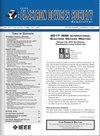Efficient Quantum Dot Light-Emitting Diodes With DAA Doped Electron Transport Layer
IF 2
3区 工程技术
Q3 ENGINEERING, ELECTRICAL & ELECTRONIC
引用次数: 0
Abstract
Zinc oxidenanoparticles (ZnO NPs) is widely used as electron transport layer material in quantum dot light-emitting diodes (QLED) due to its high carrier mobility, unique photoelectric properties and good stability. However, because ZnO has higher electron mobility than organic hole transport materials, the carrier transport is unbalanced. In addition, ZnO NPs has many surface defects, which is easy to capture electrons or holes, increasing the probability of non-radiative recombination. To solve these problems, we carefully selected an organic compound diallylamine (DAA) doping method to modify the surface of ZnO. DAA is found to not only reduce the quenching at the interface between ZnO and QD, but also regulate the energy level position to promote the carrier injection balance of QLED devices. Compared with control ZnO QLED, the external quantum efficiency (EQE) of the red QLED with DAA-modified ZnO NPs is significantly improved, the peakEQE of the devices increased by 21% from 18.8% to 23.6%. respectively. It is a simple and economical solution for manufacturing high-performance QLED.具有 DAA 掺杂电子传输层的高效量子点发光二极管
氧化锌纳米粒子(ZnO NPs)因其高载流子迁移率、独特的光电特性和良好的稳定性,被广泛用作量子点发光二极管(QLED)的电子传输层材料。然而,由于氧化锌的电子迁移率高于有机空穴传输材料,因此载流子传输不平衡。此外,ZnO NPs 表面缺陷多,容易捕获电子或空穴,增加了非辐射重组的概率。为了解决这些问题,我们精心选择了一种有机化合物二烯丙基胺(DAA)掺杂法来修饰氧化锌表面。研究发现,DAA 不仅能减少 ZnO 和 QD 之间界面的淬灭,还能调节能级位置,促进 QLED 器件的载流子注入平衡。与对照 ZnO QLED 相比,使用 DAA 修饰 ZnO NPs 的红色 QLED 的外部量子效率(EQE)显著提高,器件的峰值 EQE 分别从 18.8% 提高到 23.6%,提高了 21%。这是制造高性能 QLED 的一种简单而经济的解决方案。
本文章由计算机程序翻译,如有差异,请以英文原文为准。
求助全文
约1分钟内获得全文
求助全文
来源期刊

IEEE Journal of the Electron Devices Society
Biochemistry, Genetics and Molecular Biology-Biotechnology
CiteScore
5.20
自引率
4.30%
发文量
124
审稿时长
9 weeks
期刊介绍:
The IEEE Journal of the Electron Devices Society (J-EDS) is an open-access, fully electronic scientific journal publishing papers ranging from fundamental to applied research that are scientifically rigorous and relevant to electron devices. The J-EDS publishes original and significant contributions relating to the theory, modelling, design, performance, and reliability of electron and ion integrated circuit devices and interconnects, involving insulators, metals, organic materials, micro-plasmas, semiconductors, quantum-effect structures, vacuum devices, and emerging materials with applications in bioelectronics, biomedical electronics, computation, communications, displays, microelectromechanics, imaging, micro-actuators, nanodevices, optoelectronics, photovoltaics, power IC''s, and micro-sensors. Tutorial and review papers on these subjects are, also, published. And, occasionally special issues with a collection of papers on particular areas in more depth and breadth are, also, published. J-EDS publishes all papers that are judged to be technically valid and original.
 求助内容:
求助内容: 应助结果提醒方式:
应助结果提醒方式:


